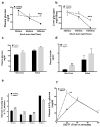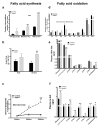Role of the tumor suppressor IQGAP2 in metabolic homeostasis: Possible link between diabetes and cancer
- PMID: 25254002
- PMCID: PMC4169985
- DOI: 10.1007/s11306-014-0639-9
Role of the tumor suppressor IQGAP2 in metabolic homeostasis: Possible link between diabetes and cancer
Abstract
Deficiency of IQGAP2, a scaffolding protein expressed primarily in liver leads to rearrangements of hepatic protein compartmentalization and altered regulation of enzyme functions predisposing development of hepatocellular carcinoma and diabetes. Employing a systems approach with proteomics, metabolomics and fluxes characterizations, we examined the effects of IQGAP2 deficient proteomic changes on cellular metabolism and the overall metabolic phenotype. Iqgap2-/- mice demonstrated metabolic inflexibility, fasting hyperglycemia and obesity. Such phenotypic characteristics were associated with aberrant hepatic regulations of glycolysis/gluconeogenesis, glycogenolysis, lipid homeostasis and futile cycling corroborated with corresponding proteomic changes in cytosolic and mitochondrial compartments. IQGAP2 deficiency also led to truncated TCA-cycle, increased anaplerosis, increased supply of acetyl-CoA for de novo lipogenesis, and increased mitochondrial methyl-donor metabolism necessary for nucleotides synthesis. Our results suggest that changes in metabolic networks in IQGAP2 deficiency create a hepatic environment of a 'pre-diabetic' phenotype and a predisposition to non-alcoholic fatty liver disease (NAFLD) which has been linked to the development of hepatocellular carcinoma.
Figures





Similar articles
-
Abrogation of hepatic ATP-citrate lyase protects against fatty liver and ameliorates hyperglycemia in leptin receptor-deficient mice.Hepatology. 2009 Apr;49(4):1166-75. doi: 10.1002/hep.22774. Hepatology. 2009. PMID: 19177596
-
Administration of isoliquiritigenin prevents nonalcoholic fatty liver disease through a novel IQGAP2-CREB-SIRT1 axis.Phytother Res. 2021 Jul;35(7):3898-3915. doi: 10.1002/ptr.7101. Epub 2021 Apr 16. Phytother Res. 2021. PMID: 33860590
-
Development of hepatocellular carcinoma in Iqgap2-deficient mice is IQGAP1 dependent.Mol Cell Biol. 2008 Mar;28(5):1489-502. doi: 10.1128/MCB.01090-07. Epub 2008 Jan 7. Mol Cell Biol. 2008. PMID: 18180285 Free PMC article.
-
Hepatic lipid accumulation: cause and consequence of dysregulated glucoregulatory hormones.J Endocrinol. 2017 Jul;234(1):R1-R21. doi: 10.1530/JOE-16-0513. Epub 2017 Apr 20. J Endocrinol. 2017. PMID: 28428362 Review.
-
Energy metabolism in the liver.Compr Physiol. 2014 Jan;4(1):177-97. doi: 10.1002/cphy.c130024. Compr Physiol. 2014. PMID: 24692138 Free PMC article. Review.
Cited by
-
Comparative analysis of basal and etoposide-induced alterations in gene expression by DNA-PKcs kinase activity.Front Genet. 2024 Mar 21;15:1276365. doi: 10.3389/fgene.2024.1276365. eCollection 2024. Front Genet. 2024. PMID: 38577247 Free PMC article.
-
Identification of Senescence-Associated Biomarkers in Diabetic Glomerulopathy Using Integrated Bioinformatics Analysis.J Diabetes Res. 2024 Jan 23;2024:5560922. doi: 10.1155/2024/5560922. eCollection 2024. J Diabetes Res. 2024. PMID: 38292407 Free PMC article.
-
Comprehensive analysis of the expression and prognosis for IQ motif-containing GTPase-activating proteins in hepatocellular carcinoma.BMC Cancer. 2022 Nov 1;22(1):1121. doi: 10.1186/s12885-022-10204-3. BMC Cancer. 2022. PMID: 36320006 Free PMC article.
-
Role of IQ Motif-Containing GTPase-Activating Proteins in Hepatocellular Carcinoma.Front Oncol. 2022 Jun 16;12:920652. doi: 10.3389/fonc.2022.920652. eCollection 2022. Front Oncol. 2022. PMID: 35785216 Free PMC article. Review.
-
Identification of Novel Genes Involved in Hyperglycemia in Mice.Int J Mol Sci. 2022 Mar 16;23(6):3205. doi: 10.3390/ijms23063205. Int J Mol Sci. 2022. PMID: 35328627 Free PMC article.
References
-
- Kuroda S, et al. Identification of IQGAP as a putative target for the small GTPases, Cdc42 and Rac1. J Biol Chem. 1996;271(38):23363–7. - PubMed
-
- McCallum SJ, Erickson JW, Cerione RA. Characterization of the association of the actin-binding protein, IQGAP, and activated Cdc42 with Golgi membranes. J Biol Chem. 1998;273(35):22537–44. - PubMed
Grants and funding
LinkOut - more resources
Full Text Sources
Other Literature Sources
